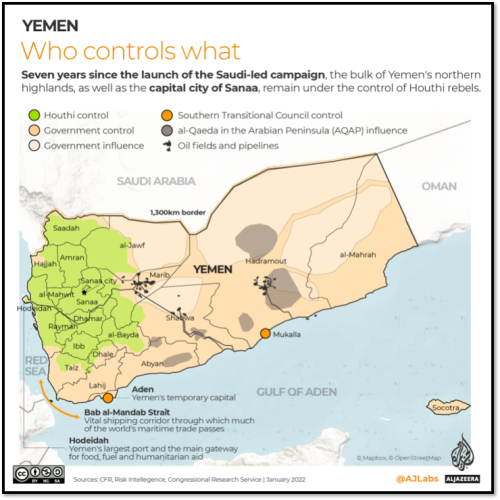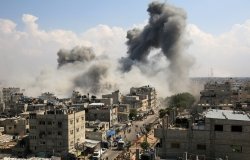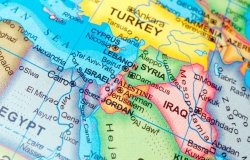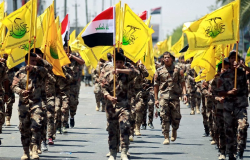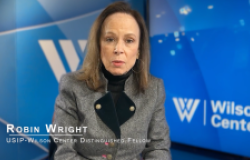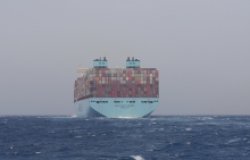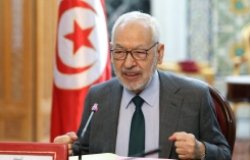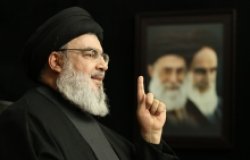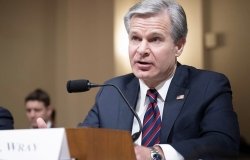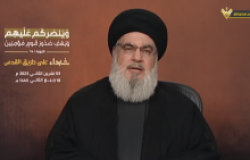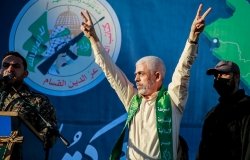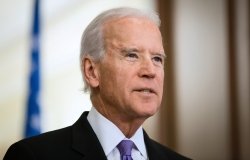Who are Yemen's Houthis?
Iran is widely accused of backing the Houthis, a Zaydi Shiite movement that has been fighting Yemen’s Sunni-majority government since 2004.
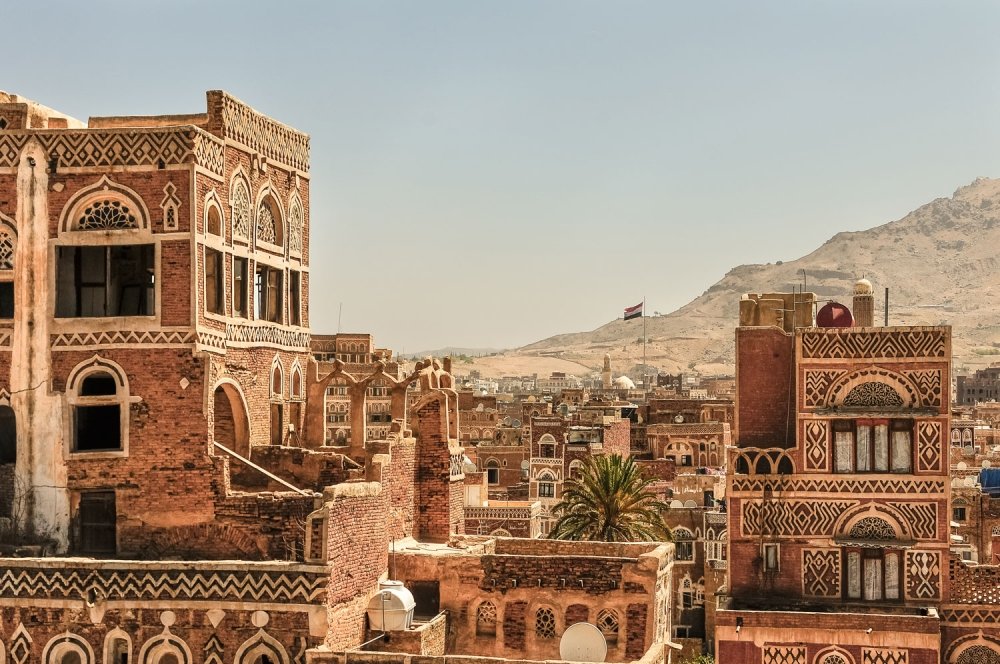
Shutterstock.com
Iran is widely accused of backing the Houthis, a Zaydi Shiite movement that has been fighting Yemen’s Sunni-majority government since 2004. The Houthis took over the Yemeni capital Sanaa in September 2014 and seized control over much of north Yemen by 2016. Yemeni officials and Sunni states have repeatedly alleged that Iran and its proxy Hezbollah have provided arms, training, and financial support to the Houthis. But Iranian and Hezbollah officials have denied or downplayed the claims. The United States, in coordination with Saudi Arabia, has presented physical evidence of Iranian arms transfers to the group.
Houthi-Saudi Tensions
The Houthi movement emerged in northern Yemen in the 1990s, in part, as a reaction to rising Saudi financial and religious influence. In November 2009, the Houthis crossed into Saudi Arabia amid their rebellion against Yemen’s central government. For the first time, the Saudi army deployed abroad without an ally. The Saudis launched air strikes against the rebels and engaged in ground skirmishes. More than 130 Saudis died.
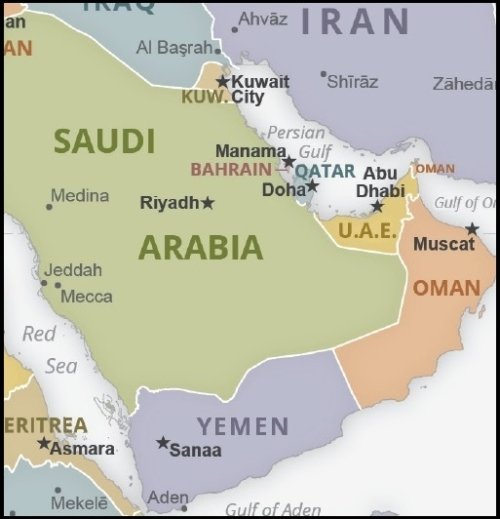
The next major round of Saudi-Houthi fighting began in March 2015. A coalition led by Saudi Arabia and the United Arab Emirates (UAE) launched airstrikes against Houthi targets in Yemen. The war between the Houthis and Yemen’s internationally recognized government and its supporters dragged on, despite U.N. efforts to broker peace talks.
Tensions between the Saudi-led coalition and Iran escalated sharply on November 4, 2017, when a ballistic missile was fired at King Khalid International Airport in Riyadh. The Houthis claimed responsibility for the attack, the first time a ballistic missile had come so close to the capital since the start of the war. The Saudi Defense Ministry claimed that it had intercepted the missile. Saudi Foreign Minister Adel al Jubeir called the attack an act of war by Iran. “It was an Iranian missile, launched by Hezbollah, from territory occupied by the Houthis in Yemen,” he said. U.S. President Donald Trump also accused the Islamic Republic. “A shot was just taken by Iran, in my opinion, at Saudi Arabia…and our system knocked the missile out of the air,” he said.
Tehran rebuffed the Saudi and U.S. claims as “false, irresponsible, destructive and provocative.” In Lebanon, Hezbollah leader Hassan Nasrallah refuted allegations of the group’s involvement as “silly” and “completely baseless.” In response to the attack, Saudi Arabia imposed a near-total blockade on Yemen.
The situation further deteriorated when the Houthis killed ex-president Ali Abdullah Saleh on December 4, 2017. Saleh had officially aligned with the Houthis in May 2015, helping them gain control over much of northern Yemen. But the alliance was shaky at best. In August, one of Saleh’s top advisers was shot and killed following a confrontation with the Houthis. On December 2, Saleh publicly split from the Houthis, seeking a “new page” with the Saudi-led coalition. “I call upon the brothers in neighboring states and the alliance to stop their aggression, lift the siege, open the airports and allow food aid and the saving of the wounded and we will turn a new page by virtue of our neighborliness,” he said. Two days later he was killed by Houthi rebels in a roadside ambush.
Iranian officials celebrated Saleh’s death. Ali Akbar Salehi, the director of Iran’s nuclear program and a former foreign minister, said that Saleh got what he deserved, Fars News Agency reported. A senior advisor to Supreme Leader Ayatollah Ali Khamenei said that Saleh’s death would help the Yemeni people “determine their own fate” free of Gulf influence. “The United Arab Emirates and Saudi Arabia conspiracy was foiled by the people of Yemen,” Ali Akbar Velayati said.
In 2018, Houthi missile attacks on Saudi Arabia became increasingly common. The group also grew increasingly bold in its choice of targets. It damaged a Saudi oil tanker in July 2018. The fighting exacerbated what the United Nations called the “world’s worst humanitarian crisis.” More than 23 million people – 80 percent of Yemen’s population – needed humanitarian aid and protection, the U.N. reported.
On September 14, 2019, the Houthis claimed credit for drone attacks on two key oil installations in Saudi Arabia. But U.S. intelligence presented to the U.N. Security Council reportedly demonstrated that the attack originated from within Iran, not Yemen. Secretary of State Mike Pompeo accused Iran of perpetrating the “unprecedented attack on the world’s energy supply.” Iranian Foreign Minister Mohammad Javad Zarif dismissed the U.S. claims in a tweet.
The Houthis widened the scope of the conflict in early 2022 by targeting UAE with drones and ballistic missiles. Emirati and U.S. military forces intercepted two ballistic missiles fired by the Houthis toward Abu Dhabi on January 24. The 2,000 U.S. troops housed at Al Dahfra Air Base sheltered in bunkers and fired Patriot missiles in response. A Houthi spokesperson warned that the UAE had “become an unsafe country.”
The following is an overview of the Houthi movement, including its origins, religious inspiration and alleged links to Iran.
Where are the Houthis from? What role have they played in Yemen's history?
The Houthis are a large clan originating from Yemen’s northwestern Saada province. They practice the Zaydi form of Shiism. Zaydis make up around 35 percent of Yemen’s population.
A Zaydi imamate ruled Yemen for 1,000 years, before being overthrown in 1962. Since then, the Zaydis – stripped of their political power – have struggled to restore their authority and influence in Yemen. In the 1980s, the Houthi clan began a movement to revive Zaydi traditions, feeling threatened by state-funded Salafist preachers who established a base in Houthi areas. Not all Zaydis, however, align with the Houthi movement.
Houthi insurgents have clashed with Yemen’s government for more than a decade. Since 2011, the Houthi movement has expanded beyond its Zaydi roots and become a wider movement opposed to the central government. The insurgents have also begun referring to themselves as Ansarullah, or “Party of God.”
How does Zaydism compare to the type of Shiism practiced in Iran?
Like other Shiites, Zaydis believe that only descendants of the Prophet Mohammed’s cousin and son-in-law, Ali, have the right to lead the Muslim community as imams - divinely-appointed successors of the Prophet. Most adherents of Zaydism reside in Yemen, and Zaydis make up around eight percent of the world’s 70 million Shiites.
But the Zaydis are distinct from the “Twelver” form of Shiism practiced by the majority of the world’s Shiites, including most Shiites in Iran. Twelver Shiites believe the twelfth imam, whom they consider infallible, disappeared in 874AD and will one day return to usher in an age of justice as the Mahdi, or promised one. In the Mahdi’s absence, Twelver Shiites believe clerics can substitute for his authority on certain issues. The faithful are obliged to obey the clerics’ religious rulings, a power transferred to Iran’s theocracy after the 1979 revolution.
Zaydis, also known as “Fivers,” believe that Zayd, the great-grandson of Ali, was the rightful fifth imam. But Twelver Shiites consider Zayd’s brother, Mohammad al Baqir, the fifth imam. The Zaydis do not recognize the later Twelver imams, and instead believe anyone related to Ali is eligible to lead the Muslim community. They also reject the Twelver doctrine that the imam is infallible.
The Houthis’ close connections to Iran, however, seem to have led to an increase in Twelver influence. “Twelver Shiite practices that are novel to Yemen are increasingly being incorporated into religious practice; for example, the commemoration of Ashura was publicly celebrated by Houthi supporters en masse for the first time in 2017, and Yemeni Shiites now openly observe Eid al-Ghadir, a Shiite religious celebration rumored to have been practiced mostly in secret previously,” according to Sama’a Al-Hamdani. The movement’s leadership has close ties to Iran’s Islamic Revolutionary Guard Corps and Lebanese Hezbollah.
Who is supporting the Houthis? How?
Iranian officials have supported the Houthis’ cause and compared the group to Hezbollah. “Iran supports the rightful struggles of Ansarullah in Yemen and considers this movement as part of the successful Islamic Awakening movements,” Ali Akbar Velayati, a senior advisor to Supreme Leader Khamenei, said in October 2014. But Tehran has repeatedly denied providing arms, funds or training to the Houthis.
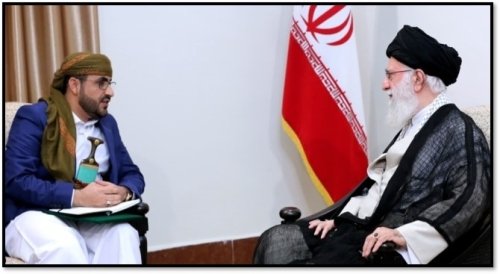
Saudi Arabia has long accused Iran of arming the Houthis to fight a proxy war. “We are worried about…the tendencies of Iran in the region, which is one of the leading elements implanting instability in the region,” the late Saudi Foreign Minister, Prince Saud al Faisal, said in 2015.
In October 2016, a U.S. admiral said that U.S. Navy and allied nations’ warships had intercepted five weapons shipments from Iran to the Arabian Peninsula since April 2015. The shipments reportedly included anti-tank missiles, sniper rifles and thousands of AK-47 automatic rifles. “These accusations are totally false,” Iranian Foreign Ministry spokesman Bahram Ghasemi (left) said in response.
In April 2017, Secretary of State Rex Tillerson said that Iran supports the Houthis’ “attempted overthrow of the government by providing military equipment, funding, and training, thus threatening Saudi Arabia’s southern border.” In November 2017, however, Revolutionary Guards commander Maj. Gen. Ali Jafari claimed that “Iran’s assistance is at the level of advisory and spiritual support.”
Tensions over Iranian support of the Houthis escalated in late 2017. In November, Saudi Arabia charged Iran with an act of war for a missile fired at the Saudi capital by the Houthis in Yemen. Iran denied any links to the attack. But remnants of four ballistic missiles fired into Saudi Arabia by the Houthis on May 19, July 22, July 26 and November 4, 2017 appear to have been designed and manufactured by Iran, according to a confidential U.N. report from November 2017.
"The United States welcomes this report, as should every nation concerned about Iranian expansion," U.S. ambassador to the United Nations Nikki Haley said on December 14, in front of the remains of a missile allegedly fired by the Houthis into Saudi Arabia. "It was made in Iran, then sent to Houthi militants in Yemen. From there it was fired at a civilian airport, with the potential to kill hundreds of innocent civilians in Saudi Arabia." The Qiam is thought to have a maximum range of nearly 500 miles.
Iranian officials and Houthi leaders denied the U.S. allegations. "After three years of war, America suddenly finds evidence that Iran supports the Houthis," a Yemeni spokesman said, according to Reuters. "America did not find any evidence in all the missiles fired from Yemen until now. The story is clear. They want to give Arabs a story to divert their attention from Jerusalem. Instead being angry at Israel, they wave the Iranian boy," he added.
On December 21, the U.S. State Department echoed Haley's allegations. "There is a very key relationship between the Iranians and the Houthis," Tim Lenderking, deputy assistant secretary for Near Eastern Affairs, said. "I don’t want to overstate it. I don’t want to suggest that the Houthis operate entirely at the behest of the Iranians. But it’s an important relationship and one that the Iranians are able to exploit." Lenderking encouraged reporters to visit the display of missile remains and other military equipment that Haley highlighted the previous week.
In January 2018, a U.N. report concluded Iran had violated an arms embargo by failing to prevent the Houthis from obtaining Iranian missiles. Iran did not comment on the U.N. panel report, but Iranian foreign minister Javad Zarif denied U.S. claims of Tehran's missile support once again in a series of tweets in late January 2018.
Less than two weeks later, however, Houthi spokesman Mohammad Abdul Salam met with Zarif in Tehran. Abdul Salam updated Zarif on the current conditions in Yemen. Zarif outlined Iran's four-point peace plan for Yemen and stressed the need for an immediate end to the war. He also called for the immediate shipment of humanitarian aid to Yemeni civilians.
In February 2018, the United States, Britain, and France drafted a U.N. resolution that condemned Iran for violating the Yemen arms embargo by failing to prevent the Houthis from obtaining Iranian missiles. Russia vetoed the resolution.
The Houthis stepped up their attacks on Saudi Arabia in the following months. In late March 2018, the rebels fired seven missiles at Saudi Arabia in one night and resulted in the of an Egyptian resident. A few weeks later, they struck a Saudi oil tanker in international waters west of Yemen's Hodeidah port.
A mid-April 2018, a missile targeting the Saudi capital Riyadh prompted a U.S. response. The State Department condemned the attack and blamed Iran for its alleged Houthi support. "We support the right of our Saudi partners to defend their borders against these threats, which are fueled by the Iranian regime’s dangerous proliferation of weapons and destabilizing activities in the region," said State Department spokesperson Heather Nauert.
Foreign Minister Javad Zarif accused the United States of fabricating evidence related to the displayed missile parts recovered from Saudi Arabia. One featured logo was from the Standard Institute of Iran, which regulates consumer goods, not weapons, Zarif told the Associated Press during a visit to New York in late April 2018. “It’s a sign of quality,” Zarif said. “When people want to buy it, they look at whether it’s been tested by the Standard Institute of Iran that your cheese puffs are good, your cheese puffs will not give you a stomach ache. I mean, nobody will put the logo of the Standard Institute of Iran on a piece of missile.”
In November 2018, the State Department claimed that Iran’s support for the Houthis had deepened. Brian Hook, the special envoy for Iran, unveiled a sampling of weapons allegedly manufactured in Iran and transferred to Yemen, including a Sayyad 3C surface-to-air missile with a range of 46 miles and two types of anti-tank guided missiles. Hook also said components of a Shahed 123 drone were recovered in Yemen. That model is likely a predecessor of the Shahed 129, which flies at a medium altitude and can endure long missions.
In January 2019, the U.N. Panel of Experts on Yemen reported that the Houthis were gaining access to increasingly advanced drone technology. “The unmanned aerial vehicles continued to be used in significant numbers in Yemen, implying that the Houthi forces retained access to the critical components, such as engines, guidance systems, from abroad that are necessary to assemble and deploy them.” The experts warned that the Houthis gained access to an additional drone in mid-2018 with the potential range of up to 932 miles. “It would give credence to the claims by the Houthis that they have the capability to hit targets such as Riyadh, Abu Dhabi and Dubai,” they wrote. The panel also highlighted the wide use of “suicide or kamikaze drones,” drones fitted with explosives that crash into their targets. The report noted that the most-commonly used Houthi drone was the Qasef-1, first seen in the field in 2016, which is similar to the Iranian-made Ababil-2/T suicide drone.
In February 2022, U.S. Central Command implicated Iran in providing advanced weaponry to the Houthis after they fired ballistic missiles at Abu Dhabi. “Medium range ballistic missiles that were fired from Yemen and entered UAE were not invented, built, designed in Yemen,” General Kenneth McKenzie told reporters. “All that happened somewhere else. So I think we certainly see the Iranian connection to this.”
The Houthis have other sources of support, however. They have reportedly received funding from local supporters and sympathetic charities as well as from illegal trade.
What are the Houthis' political views?
The Houthis do not promote a coherent ideology, and their political platform is vague and contradictory. The original Houthi insurgents desired to imitate Hezbollah, to have power without actually ruling. “The Houthis have always been on the outside. They've been a militia group that's now starting to dabble in politics,” Yemen expert Gregory Johnsen, who studied and lived in the country for years, told NPR’s “Fresh Air” in April 2015. “And they don't really know how to rule.”
The Houthi emblem only offers a broad view of the group’s views. It is made of up entirely of the following phrases, “God is great, Death to America, death to Israel, damnation to the Jews, victory to Islam.” But the Houthis’ Hezbollah-like denunciation of the United States and Israel often seems “largely for show,” according to Les Campbell at the National Democratic Institute. Their ties to former president Saleh threaten to expose the group as “just another group sharing in the spoils of corruption.”
The Houthis’ Zaydi roots do not necessarily dictate their approach to politics. Their leaders have claimed they are not attempting to revive the Zaydi imamate, but rather to seek greater political inclusion. Since 2011, they have used nationalist and populist language in their messaging rather than framing themselves as a strictly Zaydi movement. And they have cultivated a range of Sunni political allies.
The Houthis participated in the U.N.-sponsored National Dialogue Conference from 2013 to 2014. While they did not reject the reform agenda in principle, the Houthis opposed proposals to convert Yemen into a six-region federalist state. The proposal would link Saada with Sanaa, but the Houthis want Saada to be its own autonomous region.
What are the roots of the Houthis' conflict with the central government?
Hussein Abdreddin al Houthi, a prominent Zaydi cleric and member of parliament from 1993 to 1997, became a strong critic of President Ali Abudllah Saleh in the 1990s. He accused the government of aligning too closely with the United States and Israel. Tensions mounted further after President Saleh reportedly cut funding to Hussein al Houthi in 2000. Frustrated by the Zaydis’ poor political and economic status, he began rallying supporters for anti-government demonstrations in the early 2000s.
The government issued a warrant for al Houthi’s arrest, and his followers began clashing violently with security forces. Al Houthi was killed by security forces in 2004. Since then, his relatives and supporters have waged six uprisings against the government, known as the Houthi wars. President Saleh accused Iran of supporting the rebellions. The Houthis signed a ceasefire agreement with the government in 2010, but joined the Arab Spring protests against Saleh one year later.
How did the Houthis rise to power?
After months of protests, President Saleh ceded power to his deputy, Abd Rabbuh Mansour al Hadi in November 2011. But Hadi enjoyed little popular support in Yemen, and the Houthis took advantage of the power vacuum in the north. From 2012-2013, they gained followers and allies. They consolidated their territorial control, pushing south towards Sanaa.
In September 2014, the Houthis took over the capital. They initially agreed to a U.N.-brokered peace deal that required them to withdraw from Sanaa following the formation of a unity government.
But in January, the Houthis rejected the government’s newly drafted constitution and took over the presidential palace. President Hadi and his government resigned on January 22. The next month, the Houthis announced that a five-member presidential council would replace Hadi.
Hadi fled south to Aden and revoked his resignation, declaring himself the legitimate president of Yemen. In response, Houthi insurgents began bombing Hadi’s Aden headquarters.
At Hadi’s request, Saudi Arabia – along with a coalition of nine other Sunni nations – began launching airstrikes against Houthi positions on March 26. The Houthis remained defiant. “Our fighters will not evacuate from the main cities or the government institutions,” Houthi leader Abdul-Malik al Houthi said on April 19. “Anyone who thinks we will surrender is dreaming.”
On April 21, Saudi officials announced the end of the campaign, known as operation “Decisive Storm,” claiming they had successfully degraded the Houthis’ military infrastructure. The Houthis also agreed to meet several U.N. demands, including releasing the Yemeni Defense Minister, whom they were holding captive. But Saudi Arabia resumed airstrikes two days later, and the first month of the campaign had neither driven the Houthis from Sanaa nor restored Hadi to power.
Multiple attempts at peace talks organized by the United Nations failed. The first two attempts were in Switzerland in June and December 2015. The United Nations tried again in Kuwait in April 2016, but discussions broke down in August and fighting between the Houthis and pro-government forces resumed.
As of March 2017, seven ceasefire agreements had been broken in the conflict. In December 2017, after 30 months of the Saudi-led campaign in Yemen, the Houthi’s were largely in control of northern Yemen.
In December 2018, the warring parties met in Stockholm, Sweden, for the first talks in two years. They agreed to a ceasefire, prisoner exchange and coalition troop withdrawal from the port of Hodeidah, which handles the majority of imports. But the truce broke down by early 2019.
In April 2022, the Houthis and the Yemeni government agreed to two-month truce brokered by the United Nations. The United States and Iran welcomed the first nationwide ceasefire since 2016. In June 2022, the warring parties agreed to extend it for another two months. “The truce represents a significant shift in the trajectory of the war and has been achieved through responsible and courageous decision making by the parties,” Hans Grundberg, the U.N. special envoy for Yemen, said in a statement.
What is the relationship between Houthis and other Islamists in Yemen?
The Houthis have a tense relationship with Islah, a Sunni Islamist party with links to the Muslim Brotherhood. Islah claims the Houthis are an Iranian proxy, and blames them for sparking unrest in Yemen. The Houthis, on the other hand, have accused Islah of cooperating with al Qaeda in the Arabian Peninsula (AQAP).
After the Houthis took over Sanaa in September 2014, Islah initially took a few steps towards reconciliation. In November, top Islah and Houthi leaders met to discuss a political partnership. Islah called on the Houthis to cease attacks on Islah members and to release Islah prisoners. In December, the United Nations and Gulf Cooperation Council brokered a deal between the two groups to cease hostilities.
But clashes between the Houthis and Islah continued. In the first four months of 2015, the Houthis kidnapped dozens of Islah party leaders and raided their offices. By April, more than 100 Islah leaders were detained by the Houthis. Tensions increased after Islah declared support for the Saudi-led airstrikes.
The Houthis are also at odds with Sunni extremist groups. On March 20, 2015, an ISIS affiliate calling itself the Sanaa Province claimed responsibility for suicide bomb attacks on two Zaydi mosques that killed at least 135 people and injured more than 300 others. The group issued a statement that said “infidel Houthis should know that the soldiers of the Islamic State will not rest until they eradicate them.”
AQAP denied involvement in the mosque attacks, but has frequently targeted the Houthis. In April 2015, the group claimed responsibility for three suicide attacks that killed dozens of Houthis in Abyan, al Bayda’, and Lahij. AQAP has reportedly partnered with southern tribes to fight the Houthis.
Who are their leaders?
Abdul Malik al Houthi, brother of Hussein al Houthi, has been the group’s spiritual, military, and political leader since 2007. Little is known of his personal life, and he makes few public appearances. His brother-in-law, Youssef al Midani, is the deputy leader. Abdul Malik’s two brothers, Yahia and Abdul-Karim, are also senior leaders of the movement.
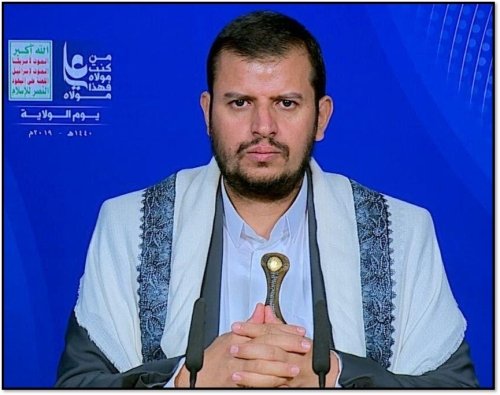
Al Masirah
On April 14, 2015, the U.S. Treasury imposed sanctions on Abdul Malik al Houthi for engaging in acts that “threaten the peace, security, or stability of Yemen.” The same month, the U.N. Security Council imposed an arms embargo against the Houthis and blacklisted Abdul Malik al Houthi.
On January 10, 2021, the Trump administration announced that it would designate the Houthis as a Foreign Terrorist Organization and as a Specially Designated Global Terrorist. The State Department accused Iran’s Revolutionary Guards of providing missiles, drones and training to the Houthis in violation of U.N. Security Council resolutions. Iran “continues to thwart the efforts of the United Nations and friendly countries to solve the crisis peacefully and end the conflict,” Pompeo said in a statement. The designation went into effect on January 19, 2021 – a day before Trump’s term ended.
The Biden administration, however, revoked the listing less than a month later. “We have listened to warnings from the United Nations, humanitarian groups, and bipartisan members of Congress, among others, that the designations could have a devastating impact on Yemenis’ access to basic commodities like food and fuel,” Secretary of State Antony Blinken said on February 12, 2021. He clarified that senior Houthi leaders – Abdul Malik al Houthi, Abd al Khaliq Badr al Din al Houthi, and Abdullah Yahya al Hakim – would remain sanctioned as individuals. The group was removed from the terrorist lists on February 16, 2021.
Timeline: The Houthis in Yemen
2014
Sept. 21-22: Houthi rebels stormed Sanaa and seized government buildings. The United Nations brokered a deal requiring President Abd-Rabbu Mansour Hadi to form a new government.
Nov. 1: Houthi rebels attacked the al Islah party headquarters in the southwestern city of Ibb.
Nov. 7-8: Hadi announced a new cabinet, but the Houthis rejected it.
Nov. 28: Houthi rebels and al Islah reached a deal agreeing to cease hostilities, but clashes between the groups continued.
Dec. 14: Houthi rebels blew up a building belonging to al Islah in Sanaa.
Dec. 20: Dozens of protestors gathered in Sanaa to demand that Houthi rebels leave the capital. Houthis respond by abducting activist Shadi Khasrouf, who participated in the protests.
2015
Jan. 22: Hadi resigned under pressure from the Houthi rebels.
March 20: Suicide attacks targeting two Houthi mosques in Sanaa killed more than 130 people and injured more than 300 others.
March 26: Saudi Arabia began launching airstrikes in Yemen in coordination with a 10-nation coalition.
Sept. 22: Hadi returned to Aden, on major city on Yemen’s southern coast, after the Houthis were driven out.
Oct. 15: The Houthis fired a Scud missile that landed near Khamis Mushayt, close to a Saudi air force base. In response, Saudi planes bombed targets in Sanaa.
Dec. 15: U.N.-sponsored peace talks began in Geneva, Switzerland and a ceasefire went into effect in Yemen.
2016
Jan. 7: Iran claimed that Saudi warplanes attacked Iran’s embassy in Sanaa. The Saudi-led coalition and Yemen’s government denied that the embassy building was targeted.
April 21: U.N.-backed talks began in Kuwait between the Houthis and Hadi’s government.
Aug. 7: U.N.-backed talks in Kuwait concluded without an agreement between the Houthis and Hadi’s government.
Oct. 19-21: The Houthis and the Saudi-led coalition agreed to a 72-hour ceasefire, allowing for civilian access to humanitarian aid. The ceasefire held for three days, and Saudi-led coalition airstrikes recommenced shortly after the truce expires.
Oct. 27: U.N. Yemen envoy Ismail Ould Cheikh Ahmed proposed a new peace plan aimed at ending the conflict. It called for members of the internationally-recognized Hadi government to step down or accept diminished roles in exchange for a Houthi withdrawal from major cities.
Oct. 31: U.S. ambassador to the United Nations, Samantha Power, called for an end to indiscriminate Saudi-led coalition airstrikes in Yemen.
Nov. 29: The Houthis and members of the ousted President Ali Abdullah Saleh’s General People’s Congress formed a new 35-minister government based in Sanaa.
2017
Jan. 18: A Houthi strike killed six civilians in the central city of Taiz, just one day after the killing of six other civilians outside of the city.
Jan. 23: Yemeni government forces seized control of the Red Sea port of Mokha after launching an assault against the port and pushing out Houthi rebels.
Jan. 30: Three Houthi suicide boats reportedly attacked a Saudi frigate off the Hodeida port in the Red Sea, killing two crew members and wounding three others. On the following day, the Houthis claimed that they had launched a ballistic missile at a Saudi-led coalition military base on the Red Sea island of Zuqar.
Feb. 22: The Houthis launched a missile at a military camp outside of Mokha and killed a senior Yemeni army general.
March 25: A court in Houthi-controlled territory sentenced President Hadi and six other government officials in absentia to death for “high treason.”
May 19: The Houthis said that they fired a ballistic missile towards Saudi Arabia’s capital, Riyadh. The Saudi-led coalition said that it intercepted the missile some 124 miles west of the city.
May 30: Oman mediated between the Saudi-backed Hadi government and the Houthi rebels over a U.N. plan for peace talks.
June 5: The Houthis banned the U.N. special envoy, Cheikh Ahmed, for allegedly abandoning his neutrality and not respecting U.N. resolutions, according to Houthi spokesman Mohammed Abdul-Salam.
June 15: Houthi rebels fired a missile at an Emirati ship carrying medical supplies in the Red Sea. One person was injured in the attack. The United Nations urged warring parties in Yemen to agree to a U.N.-negotiated deal over the management of port city Hodeidah and resuming government salary payments.
June 17: The Saudi-backed Yemen government agreed to the U.N. two-point solution regarding the Hodeidah port.
July 22: The Houthis fired a Burkan-2 ballistic missile at an oil refinery in Saudi Arabia.
July 26: Houthi rebels launched a Scud missile at an oil facility near the port city of Yanbu in Saudi Arabia.
July 29: The Houthis claimed an attack on an Emirati ship off the western coast of Yemen. But no casualties or damage were reported.
Aug. 23: Houthi fighters called their main ally, ex-president Ali Abdullah Saleh, “evil” and condemn his description of them as a “militia.” The statement highlighted a growing rift between Saleh and the Houthis.
Aug. 24: Saleh held a massive rally in Sanaa to celebrate 35 years since the founding of his General People’s Congress (GPC) party.
Aug. 27: A colonel and close adviser to Saleh was killed in clashes with Houthi rebels at a check-point in Sanaa’s southern neighborhood of Hadda.
Aug. 31: Former president Saleh demanded the arrest of the Houthi gunmen who killed his close adviser.
Early September: Leaders from Saleh’s GPC party and the Houthis met to fix the rift between both groups.
Sept. 24: President Hadi said that a military solution could solve Yemen’s crisis. “The military solution is the more likely one for the Yemen crisis in light of the intransigence of the Houthi and Saleh coup militias which continue to take orders from Iran,” Hadi said in an interview on the sidelines of the U.N. General Assembly.
Sept. 25: The Houthis detained a U.S. citizen in Sanaa.
Oct. 1: The Houthis claimed that they shot down a U.S. surveillance drone in the capital of Sanaa.
Oct. 29: Saudi Arabian Foreign Minister Adel al Jubeir said that Iran was blocking peace efforts in Yemen and was still smuggling weapons to the Houthis.
Nov. 4: Saudi Arabia said that it intercepted a ballistic missile near King Khaled Airport in Riyadh that was fired from Yemen. Saudi Arabia later blamed Iran for the Houthi missile attack on Riyadh airport.
Nov. 7: Saudi Arabian Foreign Minister Jubeir charged Iran with an act of war following the Houthi missile attack on Riyadh.
The Saudi-led coalition closed all air, land and sea ports Yemen to stem the flow of supplies and arms to the Houthis from Iran.
Nov. 8: Iranian President Hassan Rouhani said that the Houthi missile attack on Saudi Arabia was a reaction to Saudi aggression. “How should the Yemeni people react to bombardment of their country. So, they are not allowed to use their own weapons? You stop the bombardment first and see if the Yemenis would not do the same,” Rouhani said.
The White House condemned the Houthi missile attack on Saudi Arabia that occurred on November 4.
Nov. 12: The Houthis threatened to attack warships and oil tankers in retaliation for Saudi Arabia closing Yemen’s ports.
Nov. 22: The Saudi-led coalition said it was going to reopen Yemen’s Hodeida port to allow humanitarian aid through to the capital of Sanaa.
Nov. 24: Remnants of four ballistic missiles fired into Saudi Arabia by the Houthis appear were designed and manufactured in Iran, a confidential U.N. report said.
Dec. 2: Saleh publicly split with the Houthis. He called for a “new page” in his relationship with the Saudi-led coalition.
Dec. 4: Saleh was killed by the Houthis in a roadside ambush near Sanaa.
Dec. 19: Saudi Arabia intercepted a ballistic missile over southern Riyadh. The Houthis claimed responsibility for the attack, which was targeting the royal Yamama Palace in the capital. No damage was reported.
2018
Jan. 9: Houthi rebels threatened to block the Red Sea shipping lane if the Saudi-led coalition kept moving towards the Hodeidah port. “If the aggressors keep pushing toward Hodeidah and if the political solution hits wall, there are some strategic choices that will be taken as a no return point, including blocking the international navigation in the Red Sea,” the Houthis’ political council chief, Saleh al-Samad, said.
Jan. 10: The Saudi-led coalition said that it foiled an attack on a Saudi oil tanker by Houthi fighters near the Hodeidah port. The coalition destroyed a boat carrying explosives headed towards the tanker, coalition spokesman Colonel Turki al Maliki said.
Jan. 11: The Houthis fired a ballistic missile at a special forces camp and a facility housing helicopter gunships in the Saudi border province of Najran. Saudi air defense forces shot down the missile mid-air without any casualties, Colonel Maliki said.
Jan. 12: A U.N. panel concluded that Iran violated an arms embargo imposed on Yemen by failing to prevent the Houthi rebels from obtaining Iranian missiles. The report did not say that Tehran had directly supplied missiles to the Houthi rebels, but said the Islamic Republic was in "noncompliance" with Resolution 2216, for failing to keep such weapons out of Yemen.
Jan. 16: Houthi rebels said that they fired a short-range ballistic missile toward a regional airport in the Saudi border province of Jizan. Saudi defense forces said that they shot down the missile over Jizan. “This hostile action by the Houthi group, which is backed by Iran, proves the Iranian regime's continuous support for the armed Houthi group by providing them with capabilities, which is in violation of U.N. resolutions,” a spokesman for the Saudi-led coalition said.
Jan. 18: The Houthis fired a missile into the border province of Najran in Saudi Arabia. The missile targeted an air defense operations center and inflicted heavy damage to an air defense base in the Khadhra crossing point.
Jan. 25: Danny Lavon Burch, a U.S. citizen held captive by Houthi rebels since September 2017, was released and taken to Oman. He was accompanied to Oman by Mohammed Abdel-Salam, a senior Houthi leader.
Jan. 30: Houthi rebels said that they fired a long-range ballistic missile at King Khaled International Airport in Riyadh. It was the second time that the Houthis targeted the Saudi airport.
Feb. 10: Houthi spokesman Mohammad Abdul Salam met with Iranian Foreign Minister Javad Zarif in Tehran. Zarif outlined Iran's four-point peace plan for Yemen and stressed the need for an immediate stop to the war. He also called for the immediate shipment of humanitarian aid to Yemeni civilians.
The Arab coalition's Patriot air defense systems intercepted a ballistic missile fired by the Houthis from the Ras Kutayb area in the Hodeidah province. The missile was destroyed before reaching its intended target, suspected to be Mokha city in the western Yemeni province of Taiz.
Feb. 12: Major General Gameel al Mamari, a high-ranking Houthi official, defected to the Yemeni army. He had been a spokesman for the Houthis' air defense forces and a deputy director of the military forum, a group of high-ranking army officers in Sanaa.
Feb. 13: The Houthis agreed to join a new round of peace talks with the General People's Congress party in Oman. The peace talks were to take place as soon as a new U.N. Peace Envoy to Yemen was announced.
Senior Houthi field commander Abu Taha al Ghalisi was killed by pro-government forces’ shelling Houthi positions in the southwestern city of Taiz. Ghalisi was responsible for leading Houthi forces north of Taiz.
Feb. 14: The Saudi military repelled a cross border attack by Houthi rebels in the southern border town of Nathran. Around 25 Houthi militants were reportedly killed. Saudi helicopters also destroyed three Houthi military vehicles. It was the second cross--border attack by the Houthis in less than a week.
Feb. 16-26: The United States, Britain and France drafted a U.N. Security Council resolution that condemned Iran for failing to stop its ballistic missiles from falling into the hands of the Houthis. The draft also called for renewed U.N. sanctions on Yemen and would allow the Security Council to impose targeted sanctions for “any activity related to the use of ballistic missiles in Yemen.” Russia vetoed the resolution. The U.N. Security Council subsequently passed a Russian-drafted resolution that renewed the embargo and panel's mandate but omitted the Iran-Houthi issue.
Feb. 21: Mohammed Ali al Houthi submitted a letter to the United Nations to end the three-and-a-half-year war. The document, titled “An Initiative to End the Tragedies Caused by the Aggression on Yemen,” criticized the U.N. Security Council for failing “to prevent the interference and aggression against Yemen as well as the massacres committed daily against the Yemeni citizens.” The letter also included proposals for ending the conflict, such as forming a reconciliation committee, presidential and parliamentary elections, international guarantees to begin reconstruction and compensation for damages, and preventing any aggression from foreign countries against Yemen.
Feb. 27: The Houthis refused to sign a U.N.-negotiated peace agreement with the Hadi government, outgoing U.N. envoy to Cheikh Ahmed said. The Houthis rejected security arrangements that required them to pull out of cities and hand over weapons to a neutral military committee. “It became clear that the Houthis were not prepared to make concessions on the proposed security arrangements. This has been a major stumbling block towards reaching a negotiated solution,” Ahmed said in his last briefing to the U.N. Security Council.
March 1: Coalition airstrikes killed more than 100 Houthi rebels and injured dozens of fighters in the western Hodeidah district.
March 25: The Houthis fired seven missiles at four Saudi cities: three at the capital Riyadh, one at the southwest city of Khamis Mushait, one at southern Najran and two at Jizan. The Houthi Ministry of Defense claimed that the missiles hit seven different targets inside Saudi Arabia, including four airports. But the Saudi coalition said that all the missiles were intercepted and destroyed. Fragments from the intercepted missiles killed an Egyptian resident. It is the first death on Saudi soil since the military intervention began in 2015.
March 29: Houthi rebels fired a ballistic missile from the northern Yemeni province of Saada at the Saudi city of Jizan. Air defenses intercepted the missile before it could strike its target.
March 30: The Yemeni army destroyed a Houthi weapons stockpile in Saada province. The strike coincided with a coalition raid on Houthi militias in the northern province. Houthi militants had launched a ballistic missile at Saudi Arabia from the province the night before.
March 31: Saudi air defense forces intercepted a missile fired by the Houthis. The missile targeted a Saudi National Guard base in the southern city Najran, a rebel-run news agency reported. An Indian resident was injured by falling debris in the attack.
April 2: Saleh al Samad, the head of the Houthi Political Council in Sanaa, said that the rebels were “ready to buy weapons from any country that wants to sell to us, be it Russia or Iran.” But he demanded that the weapons be delivered to Sanaa to bypass the coalition blockade. Samad made the comments during a graduation ceremony speech for Houthi military cadets in Sanaa.
April 3: Houthi rebels struck a Saudi Arabian oil tanker with a missile west of Hodeidah in international waters. A coalition warship intervened and escorted the tanker, which sustained minimal damage, northwards. The Houthis said that the attack was in response to a coalition airstrike on the rebel-held Hodeidah port that killed 14 people, including women and children, the day before.
April 4: Saudi Arabia intercepted a Houthi missile that was launched at southern Jizan.
April 6: The Houthis fired a missile at the southern city Najran, Saudi Arabia. Saudi defense forces intercepted the missile. No damage or casualties were reported.
April 11: The Houthis launched a Burkan 2-H ballistic missile at the Saudi capital Riyadh and also targeted oil facilities in southern Najran and Jizan, according to the rebel's Al Masirah television network. The missile traveled more than around 500 miles into Saudi Arabia before it was intercepted by Saudi air defenses. The Saudi-led coalition said that it had also shot down two drones in southern Saudi Arabia. The Houthis claimed they targeted some areas with Qasif-1 drones.
April 12: Saudi air defense forces intercepted a Houthi missile targeting southern Jizan.
April 13: “As long as the aggression continues, our military capabilities will grow and develop,” Abdul Malik al-Houthi, the leader of the rebel group, warned . The Houthis also fired a missile at Saudi Arabia for the third day in a row. The missile targeted southern Jizan but was intercepted by Saudi defense systems.
April 15: Iran supplied the Houthis with drones used to attack Saudi Arabia, the Hadi government alleged. The drones were “made in Iran” and it was “impossible to manufacture them locally,” Yemen's internationally-recognized government said.
April 19: The Houthis reportedly shot down a U.S. drone over Hodeidah.
Saleh al Sammad, the head of the Houthis' Supreme Political Council, was killed in Saudi airstrikes on Hodeidah province, Al Masirah TV reported. Mahdi al Mashat was elected as Sammad's successor. “This crime will not break the will of our people and state ... [and] will not pass without accountability,” Abdul Malik al Houthi said. “The forces of this aggression led by Washington and the Saudi regime are legally responsible for such a crime and all its implications.”
April 22: The Houthis fired a ballistic missile at southern Najran. Saudi air defenses intercepted the missile, “but the shrapnel scattered over residential areas and cause a fire at a farm belonging to a citizen, without causing any injuries,” the Saudi Press Agency said.
April 23: Saudi Arabia intercepted two ballistic missiles at a Saudi Aramco oil production facility in southern Jizan. The Houthis claimed responsibility.
April 24: Iranian Foreign Minister Zarif accused the United States of fabricating evidence that Houthi missiles launched against Saudi Arabia were manufactured in Iran.
April 26: Saudi Arabia intercepted four ballistic missiles from Houthi rebels over southwestern Jizan. Falling debris from the interception killed one person.
April 29: The Houthis vowed to intensify rocket attacks on Saudi Arabia and said that they were manufacturing their own ballistic missiles.
Three Saudi soldiers died in clashes with the Houthis along the Yemen-Saudi Arabia border, the Saudi Press Agency said.
May 3: The U.N. envoy to Yemen, Martin Griffiths, arrived in Omani to meet with Houthi officials to try and revive peace talks.
May 6: Houthi rebels launched two ballistic missiles at Najran. Saudi air defense forces intercepted the missiles. Debris from the missiles fell on residential neighborhoods but no injuries or damage were reported. “This hostile action by the Houthi militias proves the continued involvement of the Iranian regime,” Saudi coalition spokesman Col. Turki al Maliki said.
May 9: The Houthis fired missiles at economic targets in Riyadh. Saudi Arabia intercepted one missile, and another missile landed in an uninhabited area in the desert south of the capital.
May 11: Some 40 Houthis were killed during clashes with Yemeni forces outside the city of Hodeidah.
May 14: Houthi rebels launched a ballistic missile at a Saudi Aramco facility in southern Jizan province. The missile landed in the open desert and no damage was inflicted, the Saudi-led coalition said.
May 19: Saudi Arabia intercepted ballistic missiles from the Houthis, which were targeting the city of Khamis Mushait.
May 22: The United States sanctioned five Iranians it said provided Yemen's Houthis with technical expertise and weaponry to launch attacks against Saudi Arabia.
May 29: Yemeni forces advanced within 20 kilometers of the Houthi-held Hodeidah port.
June 13: Heavy fighting resumed in the Durayhimi district south of the Hodeidah port after the Houthi rebels failed to meet a UAE deadline to surrender the port. The Saudi-UAE-backed coalition said that it had plans to ensure the provision of humanitarian aid to Yemeni civilians, even though most aid arrived through the port. The U.N. called for an emergency meeting to discuss the worsening humanitarian crisis.
June 19: Government forces seized the Hodeidah port from the Houthi rebels. The government needed control of the port to protect shipping routes and prevent the Houthis from smuggling weapons into the country.
June 25: The Saudi-led coalition announced that it had killed eight members of Hezbollah in the battle against the Houthis. Hezbollah, a Lebanese Shiite militia and political party supported by Iran, had previously denied accusations that it was providing assistance to the rebels.
July 1: The UAE paused its military campaign on Hodeidah to allow U.N. peace negotiations to be “fully explored.” The United Nations met with leaders of both parties to the civil war and suggested that an international body might assume management of Hodeida port through the negotiations.
July 5: The U.N. Office for the Coordination of Humanitarian Affairs reported that 17,350 households (over 121,000 people) had been displaced from Hodeidah in the month of June by renewed air attacks on the port city by the Saudi-led coalition. Approximately 80,000 received food and medical aid from humanitarian aid workers, but the report warned that only half of the displaced children could attend school.
July 25: Houthi rebels attacked a Saudi oil tanker in the Red Sea. The Saudi-led coalition claimed that the tanker was only slightly damaged “due to immediate intervention of the Coalition's fleet.”
July 29: The Saudi-led coalition abandoned the July 1 ceasefire and renewed airstrikes on the Hodeidah port city in response to the attack on Saudi oil tankers. Saudi Arabia also announced that it would suspend shipments through the Bab al Mandeb Strait, one of the world’s most important waterways for shipping, until the waterway was safe from similar attacks. The coalition had not made any progress in securing the port city since it launched the campaign on June 12.
July 31: The Houthis promised to suspend attacks in the Red Sea for two weeks to support peace negotiations. Mohammed Ali al Houthi suggested that the ban on attacks could be extended if the Saudi-led coalition reciprocated.
July 31: A roadside bombing in Aden wounded Aref Ahmed Ali, a prominent member of the Islah party. Three other members of Yemen’s branch of the Muslim brotherhood were also wounded.
Aug. 2: A series of explosions around Hodeidah killed 55 civilians and injured 170 more. The blasts hit crowded population centers, including a fish market and the area surrounding al Thawra hospital. Saudi Arabia blamed the Houthi rebels in a letter to the United Nations and demanded immediate disarmament and enforcement of U.N. resolutions.
Aug. 7: An investigation by the Associated Press found that the Saudi-led coalition had cut numerous deals with al Qaeda militants in Yemen, paying the fighters to retreat or recruiting them to the coalition. The deals reportedly allowed the coalition to claim victories over their enemies without engaging in combat.
Aug. 9: A coalition airstrike on Saada killed at least 29 children and wounded 30 more when it hit a school bus. Houthi-run Al-Masirah TV reported even higher numbers. The coalition defended its actions and claimed that it does not target civilians despite several accusations from human rights groups.
Aug. 31: The US military seized over 1,000 smuggled rifles from ships around the Gulf of Aden. The ships were bound for Yemen, and the sailors aboard were handed over to the Saudi-backed government after the U.S. Navy discovered the arms cache.
Sept. 9: U.N. peace talks collapsed when the Houthi delegation claimed that logistical difficulties prevented them from attending the talks. The Yemeni delegation accused the United Nations of giving the Houthis excuses to ignore a U.N. resolution.
Sept. 12: The Yemeni army, assisted by the Saudi coalition, seized two roads near Hodeidah from the Houthi rebels. The move cut off two of the Houthi’s main supply routes into the city and followed a renewal of airstrikes on the rebel forces.
Sept. 25: The Saudi-led coalition agreed to open a humanitarian aid corridor between Hodeidah and Sanaa, two rebel strongholds in Yemen. The coalition worked with the United Nations to get supplies to starving civilians.
Oct. 2: Saudi Arabia transferred $200 million to Yemen’s Central Bank to stabilize the currency amidst the world’s worst humanitarian crisis. Millions of Yemenis were already close to starving, and the currency freefall threatened even more civilians with famine. Saudi Arabia hoped to boost local economies and slow the devaluation of the rial.
Oct. 3: The Houthis released two sons of the late President Saleh in Sanaa after detaining the men for 10 months. The Houthi media agency said that the brothers were released by a pardon from the Supreme Political Council after mediation by the Sultan of Oman.
Oct. 13: President Hadi fired Prime Minister Ahmed bin Dagher and appointed Mae’en Abdulmalik Said as his replacement. The former Minister of Public Works was charged with revitalizing the collapsing economy.
Oct. 24: An airstrike reportedly killed at least 16 civilians and wounded 12 in Hodeidah province. The Saudi-led coalition hit a vegetable packaging factory in Bayt al Faqih.
Nov. 2: The Saudi-led coalition announced that it had bombed an air base near the Sanaa airport. A Houthi media outlet counted 30 airstrikes on the base and surrounding area. The coalition claimed that the Houthi rebels were using the base to launch ballistic missiles and drones, and that no commercial flights or humanitarian aid efforts were affected by the attack.
Nov. 18: In response to demands from the United Nations and a pause in Saudi attacks on Hodeidah, the Houthi rebels promised to stop missile attacks on the Saudi-led coalition. The group said it would agree to a ceasefire if the coalition was ready for peace.
Nov. 20: Outbreaks of street fighting and airstrikes around Hodeidah ended a day-long ceasefire between the Saudi-led coalition and the Houthi rebels. Residents described the fighting as the worst yet.
Dec. 2: The United Nations helped evacuate 50 wounded Houthi soldiers to Oman for treatment. The Saudi-led coalition explained the evacuation as a “confidence-building measure” ahead of a second attempt at peace talks in Sweden.
Dec. 13: U.N. Secretary General Antonio Guterres joined the final day of Yemeni peace talks in Sweden. Negotiations produced a prisoner swap, resumed oil and gas trade, reopened the Sanaa airport, and paid civilian salaries, but control of the Hodeidah port remained a pressing issue. The Houthis wanted the port to be neutral while the coalition forces insisted on government control over the port. They eventually agreed to a ceasefire and a second round of peace talks in January.
2019
Jan. 10: A Houthi drone attack on the al Anad base killed six soldiers and wounded 12 others, ending a short ceasefire negotiated with the U.N. in December.
Jan. 15: The second round of U.N. peace talks fell apart when both sides refused to sit down with the other after reports that both had violated the ceasefire agreement.
Jan. 17: The U.N. delegation overseeing the truce was fired upon in Hodeidah. An armored vehicle carrying Patrick Cammaert was struck, although no one was injured. Both the Houthis and the coalition blamed each other for the attack.
Jan. 19: The Saudi-led coalition attacked Sanaa, further eroding prospects for a peace agreement. A coalition spokesman claimed that the airstrikes targeted Houthi military facilities, which the rebels used to launch drone attacks.
Feb. 5: A round of negotiations in Amman, Jordan focused on prisoner exchanges as a critical first step in the peace process. UN Special Envoy Griffiths said that a list of thousands of prisoners would be given to the International Committee of the Red Cross and United Nations.
March 18: A report by the Norwegian Refugee Council found that the average number of civilian casualties in Yemen had doubled since the U.N. ceasefire was instituted in December. While violence in Hodeidah had decreased, increased attacks in other parts of the country had offset that reduction.
April 2: Doctors Without Borders reported that the cholera outbreak in Yemen was the worst in history with some 1.4 million cases.
April 16: President Trump vetoed a Senate resolution that proposed to withdraw American support for the Saudi-led coalition in Yemen.
May 11: The Houthi forces began to remove troops from the Saleef port in Hodeidah as a “show of commitment” to the UN-negotiated peace agreement. This was the first concession towards the agreement the Houthis made, although the Saudi coalition claimed it was a facade intended to boost the Houthi’s standing at future meetings.
May 15: Fighting resumed in Hodeidah just days after the Houthis had reportedly pulled troops out of the port.
May 25: President Hadi acccused U.N. Special Envoy Griffiths of siding with the Houthis. In a letter, he claimed Griffiths had treated the Houthis as legitimate government and that Griffiths had not held the Houthis accountable for fulfilling their promises under previous agreements.
June 3: The Saudi-led coalition captured the leader of the Yemeni ISIS affiliate along with three other ISIS members.
June 15: The Houthis launched a drone strike on Saudi Arabia’s Abha airport, the most recent of several drone and missile strikes on Saudi territory. Another strike on the Saudi Jizan airport killed 26 on June 12.
June 20: A British court ruling on arms sales to Saudi Arabia declared the use of British weapons in Yemen illegal. The historic ruling recognized a breach of international humanitarian law, setting a precedent for challenging the arms trade and reducing Western support for either party to the civil war.
Aug. 4: The Houthis reached an agreement with the World Food Programme (WFP), which allowed the U.N. aid organization to resume deliveries in rebel-held areas. The WFP had previously accused the rebels of stealing and misusing aid deliveries and suspended aid, affecting an estimated 850,000 people.
Sept. 2: Saudi-backed coalition forces bombed a prison just south of Sanaa, killing at least 60. The coalition claimed that it was targeting a weapons stash in accordance with international humanitarian law, but Houthi media said that many of the prisoners killed were due to be released in a negotiated prison swap. The Houthis accused the coalition of war crimes. It was the deadliest attack to date in 2019.
Sept. 10: Houthi militants and coalition representatives agreed to establish a de-escalation center in Hodeidah. The center, which would be overseen by the United Nations, would host “liaison and coordination officers” from both sides.
Sept. 26: After clashes with separatists supported by the UAE in Aden, the Yemeni government announced that it would move the interim capital to Ataq “until the liberation of Aden and Sanaa.”
Sept. 30: The Houthis announced that they would unconditionally release 350 prisoners who were listed in the prisoner exchange deal both parties had signed in December. The rebels claimed to have captured thousands of Saudi troops a few days earlier, but still asked their opponents to reciprocate the goodwill gesture and release their own prisoners.
Oct. 14: Saudi forces retook Aden, ending the standoff between the Saudi-backed Yemeni government and southern separatists supported by the UAE. The UAE had begun withdrawing troops from the city a few days earlier.
Nov. 5: The Saudi-backed Yemeni government signed an agreement with southern separatists intended to end coalition infighting. The Riyadh agreement called for power-sharing, a cabinet with equal representation from the north and the south, and contributions to national security from both groups.
Nov. 13: Officials from both the Saudi-backed coalition and Houthi rebels said that the two sides engaged in indirect peace talks. Oman facilitated the discussions via video conference and through European intermediaries, and said that they focused on interim goals.
Nov. 25: A U.S. warship seized a significant cache of Iranian weapons bound for Yemen’s Houthi rebels. A U.S. Navy and U.S. Coast Guard boarding team interdicted the weapons during a flag verification of a small wooden boat in the northern Arabia Sea. “An initial investigation indicates that these advanced missile components are of Iranian origin,” the Pentagon said. On December 5, the U.S. Special Representative for Iran, Brian Hook, revealed that components of anti-ship cruise missiles, land attack cruise missiles, air defense missiles, and anti-tank missiles were found. “The weapon components comprise the most sophisticated weapons seized by the U.S. Navy to date during the Yemen conflict,” he said.
2020
Feb. 13: U.S. Central Command (CENTCOM) said that it had seized a large cache of Iranian-made weapons from a dhow in the Arabian Sea. The military equipment, which included surface-to-air-missiles and anti-tank missiles, was “identical” to the weapons systems captured by the United States in the northern Arabian Sea in November, according to the CENTCOM statement. The United States “assessed” that those arms were produced by Iran and bound for Yemen’s Houthis in violation of a U.N. Security Council embargo on supplying arms to the rebels.
Feb. 17: The United Nations announced that the coalition and rebels had agreed on the first “package” of prisoners to be swapped.
July 8: Secretary of State Mike Pompeo announced that U.S. and partner forces had seized Iranian arms bound for Houthi rebels in Yemen. The weapons – including 200 rocket-propelled grenades, more than 1,700 AK rifles and various types of missiles – were found on a boat off the coast of Yemen on June 28. It was the third arms shipment interdicted by the United States since November 2019.
Aug. 26: The Southern Transitional Council (STC), Yemen’s southern separatists, withdrew from the Riyadh Agreement. The STC cited military escalation and crumbling public services for its withdrawal from the agreement, which was backed by the Saudis and intended to end violence within the anti-Houthi coalition.
Oct. 15: The Houthis and the Saudi-led coalition began a two-day prisoner swap. The U.N. brokered the exchange of more than 1,000 prisoners with support from International Committee of the Red Cross (ICRC) in Yemen. The ICRC’s Middle East director, Fabrizio Carboni, described the event as “a good first step towards building the confidence needed between parties to the conflict.”
Oct. 29: The U.S. Justice Department filed a complaint to forfeit two shipments of Iranian missiles bound for Yemen, as well as 1.1 million barrels of oil intended for Venezuela. The missiles were seized by the U.S. in November 2019 and February 2020, and the oil was captured in August 2020. The arms were allegedly sent by the Revolutionary Guards.
Nov. 25: The Houthis allowed the United Nations to assess for repairs a decaying oil tanker that has been stranded off the Yemeni coast since 2015. The tanker was moored in Houthi territory, but the surrounding ocean is controlled by the Saudi coalition, preventing the Houthis from selling the oil. A spill from the vessel could cause a significant environmental disaster and could shut down Yemen’s main Hodeidah port.
Dec. 18: The Saudi-led coalition announced a new cabinet in the internationally-recognized government that will share power between the northern and southern separatists. This new government, headed by Prime Minister Maeen Abdulmalik, united the anti-Houthi factions in Yemen whose conflicts have limited U.N efforts to establish a ceasefire.
Dec. 30: The Aden International Airport was hit by a large explosion, killing 26 and injuring at least 50. The attack came shortly after the new cabinet had landed at the airport and was followed by another explosion near the presidential palace. Yemeni Information Minister Moammar al Eryani blamed the Houthis for the explosions, but the Houthis denied responsibility.
2021
Jan. 10: Secretary of State Mike Pompeo announced that the United States would list the Houthis as a Foreign Terrorist Organization (FTO) and a Specially Designated Global Terrorist (SDGT) entity. The designations will provide additional tools to hold the Houthis accountable for “terrorist acts, including cross-border attacks threatening civilian populations, infrastructure, and commercial shipping.” The U.S. sanctions were scheduled to go into effect on January 19, the last full day of the Trump administration. Aid agencies worried that the designations and sanctions would disrupt their supply chains and aid flows; Pompeo’s statement asserted that the U.S. Department of the Treasury will issue special operational licenses to humanitarian groups.
Houthi leader Mohammed Ali al Houthi denounced the move as “terrorist" policy. The Houthis “reserve the right to respond to any designation issued by the Trump administration or any administration.”
Feb 7: The Houthis launched a campaign to capture Marib Governorate, a stronghold of the Yemeni government. Marib is strategically significant because it is the center of gas and oil production. The battle for control of Marib has continued since this date.
Feb. 10: The Houthis launched four bomb-laden drones at Abha International Airport in southern Saudi Arabia. One civilian plane caught fire.
Feb. 12: The Biden administration announced that the terrorist designation of the Houthis would be revoked on February 16. Secretary of State Antony Blinken said that its decision would ensure that U.S. policies do not impede aid efforts. “By focusing on alleviating the humanitarian situation in Yemen, we hope the Yemeni parties can also focus on engaging in dialogue.”
But Washington “remains clear-eyed about Ansarallah’s malign actions,” Blinken added. He said that the three Houthi leaders - Abdul Malik al Houthi, Abd al Khaliq Badr al Din al Houthi, and Abdullah Yahya al Hakim - designated as terrorists by the Trump administration would remain sanctioned.
Nov. 11: The Houthis had detained an unspecified number of Yemeni security guards who worked at the U.S. Embassy in Sanaa, the State Department announced. A “majority” of the staff had been released. The State Department urged the Houthis to release the remaining guards, vacate the compound and return seized property.
Dec. 25: An unspecified projectile killed two people in a store in Jazan in southern Saudi Arabia. Riyadh blamed the Houthis. On the same day, the Saudi-led coalition launched an airstrike against weapons storehouses at a Houthi camp in Ajama near Sanaa in Yemen. At least three people were reportedly killed and six others were injured.
2022
Jan 3: The Saudi-led coalition accused the Houthis of “piracy” after they seized an Emirati-flagged vessel, the Rwabee, in the Red Sea. The coalition said that the ship carried medical supplies from a dismantled field hospital. But the Houthis claimed that they found military supplies aboard. They aired footage of rifles, military-style rafts and trucks.
Jan 17: The Houthis claimed responsibility for what appeared to be a drone attack that killed three people and wounded six in Abu Dhabi. An initial report stated that small flying objects fell and may have sparked a blast that destroyed three oil tankers and started a fire at the airport. The Houthis said that five ballistic missiles and a “large number” of drones were used in the operation.
In response, the Saudi-led coalition launched airstrikes on Sanaa. At least 12 people were killed and 11 were injured, according to Al Masirah, a television station run by the Houthis. The attack targeted a residential neighborhood, according to Human Rights Watch.
Jan 20: The Saudi-led coalition launched a late-night airstrike on a telecommunications building in Hodeida that knocked out the internet across Yemen until January 25.
Jan 21: The Saudi-led coalition conducted airstrikes on a Houthi detention facility in Saada in northern Yemen. A local human rights organization reported that 82 people were killed and 162 were injured. Houthi forces reportedly shot detainees who tried to escape. Medical workers said that 16 of the dead and 35 of the injured were shot.
Jan 24: Emirati and U.S. military forces intercepted two ballistic missiles fired by the Houthis toward Abu Dhabi. The some 2,000 U.S. troops housed at Al Dahfra Air Base sheltered in bunkers and fired Patriot missiles in response. The Houthis claimed that they had launched drones and ballistic missiles at several sites, including the base. “We warn foreign companies and investors to leave the Emirates!" Yehia Sarei, the Houthi military spokesman, said. “This has become an unsafe country!” The attack marked a serious escalation in tensions.
Feb. 7: General Kenneth McKenzie, the head of U.S. Central Command, said that the United States would help strengthen UAE defenses. He implicated Iran in providing advanced weaponry to the Houthis. “Medium range ballistic missiles that were fired from Yemen and entered UAE were not invented, built, designed in Yemen,” McKenzie told reporters before arriving in Abu Dhabi. “All that happened somewhere else. So I think we certainly see the Iranian connection to this.”
March 25: A large fire was ignited at an oil depot in Jeddah a day before the start of the Formula 1 Saudi Arabian Grand Prix. The Houthis claimed to have launched missiles at Aramco facilities and drones at two refineries. Formula 1 decided to hold the races despite the attack.
April 2: A two-month ceasefire between the Houthis and the Yemeni government went into effect after U.N.-brokered peace talks. The United States and Iran welcomed the first nationwide truce since 2016.
June 2: The Houthis and the Yemeni government agreed to extend the U.N.-brokered ceasefire for another two months. “The truce represents a significant shift in the trajectory of the war and has been achieved through responsible and courageous decision making by the parties,” Hans Grundberg, the U.N. special envoy for Yemen, said in a statement. He said that he would work with the warring parties to reach a political settlement and end the war.
Cameron Glenn from the U.S. Institute of Peace, the primary author of this article, originally published it in 2015. Garrett Nada and Mattisan Rowan from the U.S. Institute of Peace updated this report.
Related Program

The Islamists
Learn more about Hamas and how it relates to similarly aligned organizations throughout the region. Read more


